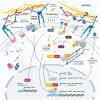Mechanosensitive Steroid Hormone Signaling and Cell Fate
- PMID: 35678467
- PMCID: PMC9237634
- DOI: 10.1210/endocr/bqac085
Mechanosensitive Steroid Hormone Signaling and Cell Fate
Abstract
Mechanical forces collaborate across length scales to coordinate cell fate during development and the dynamic homeostasis of adult tissues. Similarly, steroid hormones interact with their nuclear and nonnuclear receptors to regulate diverse physiological processes necessary for the appropriate development and function of complex multicellular tissues. Aberrant steroid hormone action is associated with tumors originating in hormone-sensitive tissues and its disruption forms the basis of several therapeutic interventions. Prolonged perturbations to mechanical forces may further foster tumor initiation and the evolution of aggressive metastatic disease. Recent evidence suggests that steroid hormone and mechanical signaling intersect to direct cell fate during development and tumor progression. Potential mechanosensitive steroid hormone signaling pathways along with their molecular effectors will be discussed in this context.
Keywords: cell fate; mechanosensitive; mechanotransduction; reproductive cancers; steroid hormones; tissue mechanics.
© The Author(s) 2022. Published by Oxford University Press on behalf of the Endocrine Society. All rights reserved. For permissions, please e-mail: journals.permissions@oup.com.
Figures


Similar articles
-
Relationship between Pituitary Gland and Stem Cell in the Aspect of Hormone Production and Disease Prevention: A Narrative Review.Endocr Metab Immune Disord Drug Targets. 2025;25(7):509-526. doi: 10.2174/0118715303314551241031093717. Endocr Metab Immune Disord Drug Targets. 2025. PMID: 39812047 Review.
-
From gene to mechanics: a comprehensive insight into the mechanobiology of LMNA mutations in cardiomyopathy.Cell Commun Signal. 2024 Mar 27;22(1):197. doi: 10.1186/s12964-024-01546-5. Cell Commun Signal. 2024. PMID: 38539233 Free PMC article. Review.
-
Interventions for acute otitis externa.Cochrane Database Syst Rev. 2010 Jan 20;(1):CD004740. doi: 10.1002/14651858.CD004740.pub2. Cochrane Database Syst Rev. 2010. PMID: 20091565
-
Corticosteroids for the treatment of Kawasaki disease in children.Cochrane Database Syst Rev. 2017 Jan 27;1(1):CD011188. doi: 10.1002/14651858.CD011188.pub2. Cochrane Database Syst Rev. 2017. Update in: Cochrane Database Syst Rev. 2022 May 27;5:CD011188. doi: 10.1002/14651858.CD011188.pub3. PMID: 28129459 Free PMC article. Updated.
-
Severe Relapsing Hailey-Hailey Disease Displaying a Durable Complete Response to Hydroxyurea.Acta Dermatovenerol Croat. 2024 Nov;32(3):168-169. Acta Dermatovenerol Croat. 2024. PMID: 40654217
Cited by
-
Deep coverage and quantification of the bone proteome provides enhanced opportunities for new discoveries in skeletal biology and disease.PLoS One. 2023 Oct 10;18(10):e0292268. doi: 10.1371/journal.pone.0292268. eCollection 2023. PLoS One. 2023. PMID: 37816044 Free PMC article.
-
Hepatoprotective effects of Xiaoyao San formula on hepatic steatosis and inflammation via regulating the sex hormones metabolism.World J Hepatol. 2024 Jul 27;16(7):1051-1066. doi: 10.4254/wjh.v16.i7.1051. World J Hepatol. 2024. PMID: 39086531 Free PMC article.
References
-
- Engler AJ, Sen S, Sweeney HL, Discher DE. Matrix elasticity directs stem cell lineage specification. Cell. 2006;126(4):677-689. - PubMed
Publication types
MeSH terms
Substances
Grants and funding
LinkOut - more resources
Full Text Sources
Medical

